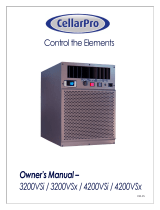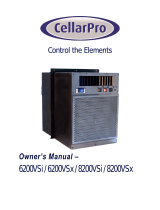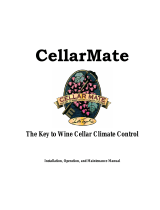Page is loading ...

V6.15.21
Control the Elements
Split Refrigeration Systems
Owner’s Manual

2 V6.15.21
[ This page intentionally left blank ]

3 V6.15.21
C O N G R A T U L A T I O N S !
Thank you for purchasing a new CellarPro cooling system.
Please take a minute to read through this Owner’s Manual before you unpack,
install and turn on your Cooling Unit.
If you have any questions about your new cooling unit, it is likely that you will find the
answers in this Owner’s Manual. We also have more information on our website,
including the latest version of the Owner’s Manual, at www.cellarpro.com/customer-
service .
IMPORTANT WARRANTY INFORMATION FOR YOUR SPLIT SYSTEM
Make sure to activate your warranty by having the installing technician complete
the Support and Data Service Sheet at the end of this Owner’s Manual. Once
completed, please fax to us at 707.794.8005, or scan and email to us at
Once we receive the completed Sheet, we'll review the data to make sure the cooling
system is installed properly.
YOUR WARRANTY WILL NOT BE ACTIVATED UNTIL WE RECEIVE THE
COMPLETED CHECKLIST AND INSTALLATION ISSUES (IF ANY) HAVE BEEN
RESOLVED. If the unit malfunctions, we cannot assist you unless/until we receive the
completed checklist. If the unit is damaged because of improper installation, repair
services will be provided on a time and materials basis.
If you need to contact us, we can be reached during normal business hours at
707.794.8000. You also may contact us anytime via email at [email protected].
Contact Information:
CellarPro Cooling Systems
1445 N. McDowell Blvd
Petaluma, CA 94954
707.794.8000
Email: [email protected]
Website: www.cellarprocoolingsystems.com

4 V6.15.21
Table of Contents
I. Package Contents 5
II. Specifications, Cut Sheets, and Cellar Construction 6
III. Installation Instructions 13
IV. Operating Instructions 32
V. Troubleshooting 42
VI. Limited Warranty 47
VII. Appendices 48
VIII. Warranty Activation Checklist 60

5
V6.15.21
I. Package Contents
3000S, 4000S
BOX 1:
DESCRIPTION QTY
EVAPORATOR 1
TOP MOUNTING BRACKET 2
SIDE MOUNTING BRACKET 2
WALL MOUNTING SCREWS 16
DRAIN TUBING 10 FT.
OWNERS MANUAL 1
CORK TAPE 1 FT.
DRAIN KNOCKOUT SNAP BUSHING 1
SIGHT GLASS 1
FILTER DRIER 1
BOX 2:
DESCRIPTION QTY
CONDENSING UNIT 1
BOX 3 (OPTIONAL):
DESCRIPTION QTY
CONDENSING UNIT OUTDOOR COVER 1 SET
COVER ASSEMBLY HARDWARE 1 SET
3000Sh, 4000Sh, 6000S, 8000S
BOX 1:
DESCRIPTION QTY
EVAPORATOR 1
REAR WALL MOUNTING BRACKET 2
WALL MOUNTING SCREWS 6
DRAIN TUBING 10 FT.
OWNERS MANUAL 1
CORK TAPE 2 FT.
DRAIN KNOCKOUT SNAP BUSHING 1
HOLE PLUGS FOR ANCHOR BOLTS 2
SIGHT GLASS 1
FILTER DRIER 1
BOX 2:
DESCRIPTION QTY
CONDENSING UNIT 1
BOX 3 (OPTIONAL):
DESCRIPTION QTY
CONDENSING UNIT OUTDOOR COVER 1 SET

6
V6.15.21
II. Specifications, Cut Sheets and Cellar Construction
Evaporator
Model
Dimensions
W x D x H (inches)
Weight
(lbs.)
Running Amps
(with fan on “high”)
3000S-EC 16.6 x 12.6 x 22.1
(incl. mounting brackets) 40 6.1
3000Sh-EC 30.4 x 14.4 x 13.2
(incl. mounting bracket) 63 5.6
4000S-EC 16.6 x 12.6 x 22.1
(incl. mounting brackets) 42 8.4
4000Sh-EC 30.4 x 14.4 x 13.2
(incl. mounting bracket) 65 7.9
6000S-EC 30.4 x 14.4 x 13.2
(incl. mounting bracket) 68 12.6
8000S-EC 46.4 x 14.4 x 13.2
(incl. mounting bracket) 85 13.8
Condensing unit - Indoor
Condensing unit - Outdoor
Model
Dimensions
W x D x H (inches)
Weight
(lbs.)
Dimensions
W x D x H (inches)
Weight
(lbs.)
3000S-EC,
3000Sh-EC 13.5 x 18.9 x 9.1 42
19.4 x 23.3 x 18.8
(with cover)
73
4000S-EC,
4000Sh-EC 13.5 x 18.9 x 10.3 45 76
6000S-EC 13.9 x 18.9 x 11.9 54 85
8000S-EC 16.8 x 20.8 x 14 76 107

7
V6.15.21
Evaporator Cut Sheets

8
V6.15.21
Evaporator Cut Sheets

9
V6.15.21

10 V6.15.21
Condensing Unit Cut Sheets

11 V6.15.21
Insulation
CellarPro cooling units are designed to be installed inside wine cellars that have
proper insulation, moisture barriers and an airtight seal from the environment
outside the cellar. Interior walls and floor should have a minimum of R-11
insulation, and a vapor barrier
on the warm side of the
insulation. The ceiling should
have a minimum of R-19
insulation and a vapor barrier
on the warm side of the
insulation. Doors also should
be insulated and tightly
sealed with weather
stripping around the
perimeter of the door.
Surface-mounted fixtures
are recommended over
recessed lighting, which can
allow air to leak into the
cellar.
It is important that all walls,
joints, doors and windows, electrical outlets and/or switches, pipes, vents and
light fixtures be sealed to prevent air and moisture from entering the cellar. If there is
a leak in the cellar, the cooling unit will build up excess condensation.
The drain line (shipped loose with the cooling unit) must be connected to the drain
pan (as shown in the installation section).
Fan Speeds
Your fan speed setting will depend on the thermal load on the wine cellar, and the
resulting BTU that is required to cool and maintain your wine cellar at the desired
temperature.
Ventilation
Adequate ventilation is critically important for the proper operation of your CellarPro
cooling unit.

12 V6.15.21
Outside the Cellar
Condensing unit Air Exhaust. Condensing units create significant hot air which
must be exhausted into an appropriately-sized space in order for the heat to
dissipate. If the space is constrained and/or too small, the heat will not dissipate.
In this event, the cooling unit will be forced to re-circulate its hot air exhaust and/or
the static pressure will back up the cooling unit. If this happens, the cooling unit’s
ability to create cold air inside the cellar will be compromised.
Condenser Air Intake. The condenser coils require access to cool air in order for
the cooling unit to produce cold air. In addition, the cooling unit must be installed
so that, after its installation, the condenser coils are accessible for periodic cleaning.
The Condensing unit cannot be ducted.
Inside the Cellar
Evaporator Air Intake
.
When the warm air passes across the evaporator coils, heat
is removed from the air, and the resulting cold air is exhausted into the cellar. To
ensure proper airflow, minimum clearance of 12” is required in front of the cooling
unit.
Evaporator Air Exhaust.
Cold air is exhausted at the top front of the cooling unit.
Because CellarPro cooling units are located at the highest point inside wine cellars,
the cold air exhaust eventually will drop to the bottom of the cellar. To ensure proper
airflow and reduce temperature stratification inside the cellar, the space in front of
the cold air discharge should be clear of any obstructions, including wine bottles, wine
racks, etc.
Ducting For the Evaporator (3000S/4000S Models). Cold air exhaust and return
(from the evaporator) can be ducted with our front duct hood up to 100 equivalent
feet of total ductwork, or 50 equivalent feet for both the discharge and return
ducting, using 8” diameter insulated ducting. Our front duct kit is compatible
exclusively with our 3000S and 4000S cooling units. If you’d like to duct one of our
larger cooling units, please consider our AH6500 and AH8500 cooling units.
Before attaching the front duct hoods, remove the front grill (if present) from the
front of cooling unit.
We also offer a remote control panel kit that can be installed remotely (up to 10 feet)
from the cooling unit, either inside or outside the cellar, and a bottle probe (10 foot
cord) that can be plugged into the cooling unit.

13 V6.15.21
III. Installation Instructions
Installation Instructions
Split System piping and wiring must be installed by a qualified Refrigeration
Technician in accordance with local and national code requirements.
Condensing Unit Installation
Indoor and Outdoor Units
The unit is designed to operate in temperatures ranging from 0°F to 110°F. A
compressor heater (sold separately) is required for temperatures below 40°F.
If the system has been sitting idle without the compressor heater energized for
more than 24 hours, or if starting up the system in a cold ambient, it is critical
to warm the bottom shell of the compressor above the ambient
temperature for 30 minutes before running the system to drive excess
refrigerant out of the compressor oil.
Indoor Units
Condensing units can be installed remotely from the cellar in an area protected
from direct exposure to moisture and sunlight.
The area must have suitable ventilation to maintain an ambient temperature of
110°F or less.
If the area does not have adequate ventilation, a vent fan should be added to
supply fresh air to the space (suggested 600CFM).
A minimum of 12" of open air space is required in front of the condenser coils.
Indoor units can be installed with the optional outdoor hood if additional
mechanical protection is desired.
A minimum of 12" of open air space around the perimeter of the outdoor hood
is required.
Outdoor Units
Condensing units must be installed with the outdoor hood if the unit will be
located outdoors. PLEASE NOTE: Our units were not designed for, and our
warranty does not cover damage from, marine exposure (within 5 miles of the
ocean). In these environments, you will need an applied coating, such as
Insitu®, to protect against corrosion that is common in coastal regions.
A minimum of 12" of open air space around the perimeter of the outdoor hood
is required.
The condensing unit must be mounted on the base with the holes aligned, as
shown below:

14 V6.15.21
Evaporator Unit Installation
As warm air rises to the top of the cellar, the cooling unit pulls the warm air through
the evaporator coil and removes the heat from the warm air. Once cooled, the cold
air is discharged from the front of the cooling unit and circulates through the cellar.
Therefore, we recommend mounting the evaporator as close to the ceiling as
possible inside the cellar.

15 V6.15.21
3000S / 4000S
Side mounting brackets are provided for mounting the evaporator flush to a wall
inside the cellar. Optional top and bottom brackets (non-load bearing) are available
upon request.

16 V6.15.21
3000Sh-EC / 4000Sh-EC / 6000S-EC / 8000S-EC
Wall hangers are used to mount these split systems. First, wall brackets are
attached to the wall, and then the evaporator slides onto the brackets. After the
evaporator is installed, two bottom nuts must be installed on the recessed anchor
studs.

17 V6.15.21
Condensate Drain Line
The condensate drain line must always have a downward pitch of 1/8” or more per
foot. Within 12 inches from leaving the evaporator, the drain line requires a trap to
overcome negative pressure. The entire trap must be below the evaporator.
In the trap, the drain line should drop, then rise, and then drop again into an open
drain or a vent tee. Water should be filled in the section of the trap between the first
drop and the rise. Please refer to the drawings below for further detail.
Before putting the unit into service, test for positive drainage by pouring water into
the drain pan and observing flow through to the final drain.
Optional Remote Display and Probe
We offer a remote control display kit that can be installed remotely from the cooling
unit, either inside or outside the cellar (because the temperature probe is not
embedded in the display). We provide 10 feet of 16-guage thermostat wiring
standard; additional length can be requested for a nominal charge, or can be
sourced locally.
We also offer a remote bottle probe with a 10 foot cord (extensions for longer
distances are also available) to override the probe on the face of the cooling unit,
and can be used to measure air or liquid temperatures inside the cellar. The remote
probe is plugged into the cooling unit on one side, and located inside the cellar on
the other side, to accurately measure cellar temperatures when the cooling unit is
located remotely from the cellar, and/or to measure liquid temperatures inside the
cellar.

18 V6.15.21

ϭϵ
s6͘ϭϱ͘Ϯ1
3RZHU6XSSO\5HTXLUHPHQWV
(9$325$725 &21'(16,1*81,7
63/,7
6<67(0)$1$036#9+= 32:(5,1387:$776 81,7$036#
9+=
32:(5
,1387
02'(/0&$+,*+ 0(' /2: +,*+ 0(' /2: 0&$/5$:$776
66K
66K
6
6
127(6
63/,7
6<67(06<67(0$036 32:(5,1387:$776
02'(/0&$/5$+,*+ 0(' /2:
66K
66K
6
6
127(6
2SWLRQ$'XDO3RZHU9DOYH&RQWURO
2SWLRQ%6LQJOH3RZHU(OHFWURQLF&RQWURO
$DPSGHGLFDWHGFLUFXLWEUHDNHUQRQ*),LVUHFRPPHQGHGIRU66KDQG66KV\VWHPV
$DPSGHGLFDWHGFLUFXLWEUHDNHUQRQ*),LVUHFRPPHQGHGIRU6DQG6V\VWHPV
6HSDUDWH9+=SRZHUVXSSOLHVDUHUHTXLUHGIRUWKH(YDSRUDWRUDQGWKH&RQGHQVLQJ8QLW
$DPSFLUFXLWEUHDNHULVUHFRPPHQGHGIRUDOO(YDSRUDWRUPRGHOV
$DPSGHGLFDWHGFLUFXLWEUHDNHUQRQ*),LVUHFRPPHQGHGIRU66KDQG66K&RQ
GHQVLQJ8QLWV
$DPSGHGLFDWHGFLUFXLWEUHDNHUQRQ*),LVUHFRPPHQGHGIRUWKH6&RQGHQVLQJ8QLW
$DPSGHGLFDWHGFLUFXLWEUHDNHUQRQ*),LVUHFRPPHQGHGIRUWKH6&RQGHQVLQJ8QLW
6,1*/(9+=32:(56833/<72)520
(9$325$725

20 V6.15.21
System Wiring – Option A: Dual Power / Valve Control
Under this configuration the Evaporator and Condensing units are separately
powered, and the Condensing unit turns on and off based on suction pressure, as
follows:
The Evaporator includes a factory installed liquid line solenoid valve (LLSV),
which is controlled by the Evaporator temperature controller. The Condensing
unit is controlled by a low pressure switch which reacts to the suction pressure
and senses whether the LLSV is open or closed.
When the Evaporator temperature set-point is reached and the Evaporator
turns off, the LLSV closes, causing the system to pump down until the low
pressure switch shuts off the Condensing unit.
When the Evaporator turns on, the LLSV opens, causing the suction
pressure to rise and activate the Condensing unit.
Field power wiring is connected to both the Evaporator and Condensing units, no
interconnecting wiring is needed between the Evaporator and Condensing unit.
Evaporator Field Power Wiring:
Connect line lead to Evaporator terminal "L"
Connect neutral lead to Evaporator terminal "N"
Connect power ground to grounding lug on Evaporator
Condensing Unit Field Power Wiring:
Connect line lead to Condensing unit terminal "L1"
Connect neutral lead to Condensing unit terminal "L2"
Connect power ground to grounding lug on Condensing unit.
/





